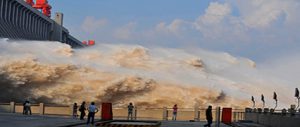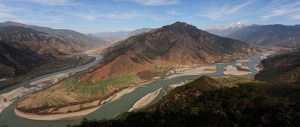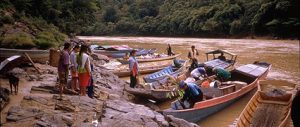Pan Jiazheng, the “chief architect” of China’s divisive Three Gorges dam, died on July 13 at the age of 85. State media called his death the “hydropower industry’s greatest loss”. But it is hard to ignore the controversy that surrounded his life.
Pan, widely seen as the representative of China’s first generation of hydropower advocates, held a litany of high-level positions: chief engineer at the Ministry of Water Resources; deputy head and chief technician of the Three Gorges dam project appraisal team; director of the Three Gorges Project Corporation technical committee; director of the expert committee of China’s South-North Water Transfer project; scholar of the Chinese Academies of Sciences and Engineering; and a member of the standing committee of the CPPCC, a political advisory body.
I never met Pan. My specialty is in law, sociology and public policy. But for many years I have closely followed the hydroelectric projects connected with him. I have taken part in the environmental assessments of four national hydroelectric projects: the Zipinggu Dam, the Nu River dams, the Longtan Dam on the Hongshui River and the Tankeng Dam on the Ou River. And I also participated in a study on the resettlement of people from the Three Gorges Dam area.
Pan was well known as a fierce advocate of the construction of the Three Gorges Dam. “Whenever I hear someone voice their objections I feel annoyed,” he once said. On many occasions, he publicly attacked these objections. Less well known is the fact that in his book The Three Gorges Dream, Pan wrote about his own nightmare – he had dreamed that he was on trial at an “international environmental court of law”, and was sentenced to be “expelled from the human race, turned into a devil forever, and sent down to hell to die a lingering death of a thousand cuts.”
Pan once said that, before he became deputy head and chief technician of the Three Gorges Project appraisal team, he was “deeply troubled” by catastrophic possibilities: the dam facing the outbreak of nuclear war; landscapes and historic sites being destroyed; of rare species going extinct; and of a worsening environment – “earthquakes, landslides, reservoir sedimentation, blocked channels and so on”. But, he continued, after three years of appraising, he switched from being an “objector” to being a “supporter”. “I discovered that the original problems I was worried about could all be easily solved,” he said. Up to his death, however, Pan never gave a convincing answer as to how these problems could be “easily solved”.
Pan believed that hydropower development was necessary for “national prosperity” and that “western” questioning of dam construction was simply a way to “limit the development of poor nations”.
In reality, this was simply the manifestation of a way of thinking that took shape during the era of the planned economy. On the one hand, there was talk about peace, development and cooperation as major global trends; on the other, the “know your enemy” mindset was constantly resurfacing. This was a situation particular to our era.
Pan was similar to many in his generation, and he had the same way of thinking: someone was either his enemy or his friend. He said: “The Three Gorges Dam is a high-grade project, a safe project, and a project that brings credit.” Time will tell whether or not it’s a high-grade project or safe. As for “bringing credit” this is a reflection of the issues of the age.
Pan described “born in poor and weak old China” as being like a nightmare pressing down on his heart. Phrases like “saving the nation”, “seeking strength”, “scientific development” and “national prosperity” masked the intense competitiveness of this generation. The motivation for their struggle came from looking at each other as the enemy. China, a victor of the Second World War, a permanent member of the UN Security Council and the second biggest economy in the world, remains in constant fear that others don’t regard it as important or give it recognition. By acting tough from time to time, a lack of confidence shows through. Every day we hear how others are bullying China and limiting our development, but not reflection on why China hasn’t yet joined the ranks of the developed nations.
Pan believed he was representative of the “Chinese people”. And as their representative, he argued that China “cannot allow the rivers to flow freely”, and should “push on with the next step in the development of grand and unprecedented water conservation projects”. In the twenty-first century, China should “build more mighty dams and reservoirs”, and turn itself into the “world’s top hydropower nation”, he urged. Everything Pan said is now becoming reality, but for those people living in China, is this a blessing or a curse?
Hydropower advocates can respond to all kinds of criticism with: “China needs to develop, and development needs energy”. But when it comes down to it, how much energy do we really need? So-called “energy shortages” are mostly caused by major industries over-producing, wasting energy and using energy improperly. The contribution of China’s energy consumption to GDP is much lower than that of some other countries. So-called “development” is based on destroying the environment and gradually creating an energy security problem. This kind of “development” is unsustainable.
When we realise our errors, we can’t just say: “You’ve already built so many dams, we still haven’t built enough. You’ve already polluted your countries, we haven’t polluted our country enough yet,” and then carrying on harming people. Moreover, there are a lot of vested interests driving the “development” of hydropower projects.
Pan wrote about the damage caused by dams – in 1960, after the Sanmenxia reservoir silted up, 250,000 mu of farmland was flooded, and 5,000 people hemmed in by water; in 1975, the Banqiao Dam and the Shimantan Dam collapsed, killing at least 26,000 people (other estimates put the number of deaths much higher, at 80,000 or even 200,000).
But he believed that, with modern technical capacity, such calamities wouldn’t happen again. Pan was an engineer, and like many of China’s technical experts, didn’t distinguish between “science” and “technology”. This group believes that, as long as they have technical development combined with financial backing, their strength will be infinite. Technology has always been a double-edged sword – the higher the level of technical development, the greater the potential harm it can inflict on humans. We live in an era in which many people – in the name of science – have blind faith in technology; and in the name of markets have blind faith in money.
In his writings, Pan talked about his personal experiences of resettlement. Before the Xinan River dam was built, he visited the reservoir area: “It was like it was facing a great plague, or it was the eve before a great battle. Everywhere was a mess, an expanse of chaos and desolation.” He added: “We really felt bad for the migrants”. Today, funds for those being resettled have risen greatly, but has the resettlement problem been resolved?
Pan said that it was the opponents of the Three Gorges Dam who made the biggest contribution to the project. But opposition voices were never heard by policymakers; they never got past the obstacles of the system. Not only did opponents of the scheme come under intense pressure, but they also lacked a platform for debate.
To prevent decisions being manipulated by stakeholders, or policy mistakes from occurring, two kinds of system are needed: the first ensures that policies are made only after a wide range of opinions have been heard; and the second coordinates and balances different interests when policies are made. Neither of these two systems is present at the moment.
The Three Gorges Dam is the only Chinese hydropower project to date that has been voted on by parliamentary body the National People’s Congress. Some 2,633 people attended the vote. Of these, 1,767 people approved, 177 opposed, 664 abstained and there were 25 “no-votes”. At the time a commentary said: “The Three Gorges Dam is the ‘beginning’ of democratic decision-making on large-scale engineering projects.” But after 20 years, this “beginning” has led nowhere – there hasn’t been another project to go to the NPC for “democratic decision-making”. We should think about whether or not we need rules about which projects should go to the NPC to be voted on and under what circumstances should we hold a public consultation.
The Three Gorges project appraisal group issued two environmental reports. The first concluded that the project “did more harm than good”, while the second came to the opposite conclusion. Some 403 specialists took part in the appraisal, nine of them refused to sign the report.
My experience of taking part in evaluations and consultations on major national projects and drafting of laws has led me to believe that, if you are invited today, then you are considered an expert, but if tomorrow you are not invited, then you are no longer considered an expert. When people are putting you under pressure to sign, it is very hard not to.
My past recommendations have included: setting up a think-tank and, when listening to its ideas, taking a random sample of specialists from different areas and giving priority to those who raise objections. I have also suggested changing the way draft documents are signed so that every specialist has to write down his or her own ideas, as well as making it compulsory for the names and ideas of all specialists taking part in policymaking or policy consultation to be made public. Specialists may support bad policies because of their own interests, or simply because they make mistakes. Of course, they cannot be held accountable in the same way as officials, but they should take the responsibility that comes with their reputation.
Often when someone passes away, people lament that “this earth will never see another person like him.” It’s a way declaring the end of an era. The death of Pan Jiazheng also saddens me and it is true that this earth will never see another like him.
The Communist Party has put forward a new policy: “Put People First”. This is a move away from the old idea of “nation first”. It’s about prioritising livelihoods and aiming for harmony between people and people, and people and nature. It’s about exploring new types of sustainable development by changing the industrial structure, growth patterns and consumer models. Will this open up a new era – the era of the post-Pan generation?
Li Dun is a professor at Tsinghua University’s Research Center on Contemporary China. The text of this article has been edited down from the author’s original paper.
Homepage image by 尹传红



